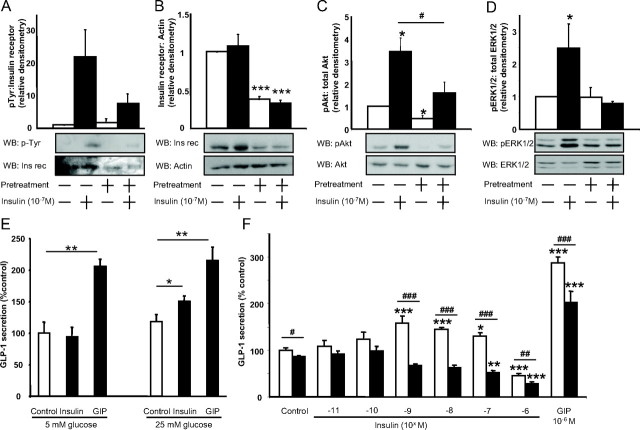Fig. 2.
Effects of insulin and insulin resistance on murine GLUTag cells. Cells were exposed for 24 h to either media alone or high insulin to induce insulin resistance and, after three 40-min washes with serum-free media containing 1% BSA, were treated acutely with 10−7 m insulin for 5 min for Western blot analysis (WB) or with the indicated concentrations of insulin or GIP for 2 h to measure GLP-1 secretion by RIA. A–D, Crude protein lysates or immunoprecipitated protein extracts were subjected to immunoblot analysis for insulin receptor (Ins rec) phosphorylation (n = 3/group) (A), total insulin receptor expression (n = 4/group) (B), Akt phosphorylation (n = 4/group) (C), or ERK1/2 phosphorylation (n = 7/group) (D). Representative blots are shown, and all values were expressed relative to the untreated control. *, P < 0.05, **, P < 0.01, ***, P < 0.001 when compared with untreated control; #, P < 0.05 as indicated. E, GLP-1 secretion in response to medium alone (control), insulin (10−8 m), and GIP (10−6 m) in the presence of 5 or 25 mm glucose. GLP-1 secretion was determined by RIA, and all data were expressed as a percent of the untreated control (n = 3–4/group. *, P < 0.05; **, P < 0.01. F, GLP-1 secretion in response to medium alone (control), insulin, or GIP from normal (open bars) or insulin-resistant (closed bars) GLUTag cells. GLP-1 secretion was determined by RIA, and all data were expressed as a percent of the untreated control (n = 5–6/group). *, P < 0.05; **, P < 0.01; ***, P < 0.001 when compared with untreated control; #, P < 0.05; ##, P < 0.01; ###, P < 0.001 as indicated. p, Phospho.

